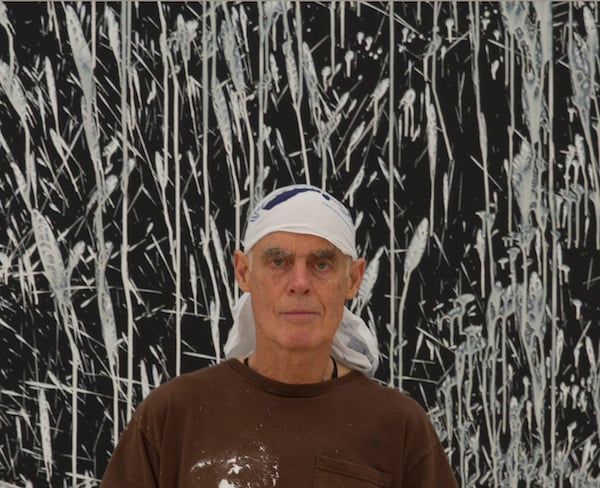
Photo: James Wainman Courtesy of Lisson Gallery
Richard Long’s latest exhibition, “Time and Space,” which opens today at the Arnolfini, could be considered a homecoming of sorts for the Bristol artist, if it wasn’t for the fact that he never really left.
Despite his successful international art career, Long always remained in Bristol, where he was born, in 1945, and where he made his first famous artwork, A Line Made by Walking (1967), at the tender age of 22.
Two years later, in 1969, his work would be included in the seminal exhibition “When Attitude Becomes Form,” curated by Harald Szeemann at the Kunsthalle Bern. And the rest is (contemporary art) history, as they say.
For Long—the creator of a unique blend of art-making that deftly combines elements of conceptual and land art with photography, drawing, and a tireless wanderlust—walking is at the very heart of his practice.
The majority of his works stem from this activity, resulting in either text pieces that conceptualize such experiences within nature, their photographic documentation, or sculptures made with materials gathered during his walks.
Installation view Richard Long’s “Time and Space” exhibition at the Arnolfini
Photo: Stuart Whipps
“Walking is universal,” Long is quoted saying in the exhibition’s text. “Journeys are common to all people and cultures and yet it interests me to make walks that follow or realize original ideas… Walking as art, in fact.”
The survey show traces Long’s oeuvre from 1967 to the present, encompassing the variety of media he has worked in throughout his career.
Richard Long’s Muddy Water Falls (2015) at the Arnolfini
Photo: Stuart Whipps
The first gallery at the Arnolfini gathers pieces from different periods that take mud as a starting point. The gestural Muddy Water Falls (2015), for example, is a large-scale mural Long has created by applying mud with his hands to an entire wall of the gallery.
“I love mud as a material,” the artist said yesterday during a press presentation. “It has fantastic properties. I like it because it makes me have to work fast.”
“I did this whole mural in about 45 minutes, then, nature did the rest,” he explained, somewhat cheekily, pointing at the lower half of the mural, which is covered in mud drips that gave the piece a stunning Abstract-Expressionist quality.
Richard Long’s Muddy Walk (1987) at the Arnolfini
Photo: Stuart Whipps
In the same gallery, the pieces Muddy Boots Walk (1991), Mud Walk (1987), Straight Miles and Meandering Miles (1985), Red Walk (1986), and Watershed (1992) capture a number of walking experiences around Bristol in wall-text pieces.
The texts are highly evocative—critics have even compared them to concrete poetry. But Long has a different view on these artworks.
“The text pieces are not poems and they are not meant to be a translation of a landscape,” he told artnet News. “The texts are the stories of sculptures, and also the distillation of my ideas when I am doing those walks. The photographs, on the other hand, show what I have done in those locations.”
Richard Long’s Time and Space (2015) at the Arnolfini
Photo: Stuart Whipps
Upstairs, the monumental sculpture Time and Space (2015), which gives the exhibition its title, takes up an entire gallery room. The right-angle cross—made with slate from the quarry in Cornwall with which Long has worked with for many years—focuses on presence, on marking, rather than on evocation or conceptualization. It’s a new piece that is, at the same time, “classic” Long territory.
An unexpected surprise, however, came in the last room, where a number of recent driftwood drawings, which Long made with his fingertips, managed to steal the show (for me).
A much lesser-known body of work, these driftwood pieces are beguiling in their small scale and unobtrusive, humble presence, which in many ways almost contradicts Long’s best known, large-scale output.
Richard Long’s recent driftwood drawings at the Arnolfini
Photo: Stuart Whipps
“I am interested in scale, from walking 1,000 miles to doing just a small painting with a fingerprint,” Long, who won the Turner Prize in 1989, told artnet News.
“The driftwood drawings are actually the only works I make at home, in my kitchen, because I don’t have a studio. I like the balance between being home and being away. I am a British artist, but I am also a world artist.”
He certainly is an artist of the world, having left his mark all over the planet, in Bolivia, Alaska, Mongolia, and the Himalayas, to mention but a few locations. But Bristol still holds a unique place in his psyche and practice. “It’s a very particular landscape, my territory, and my first works were made here. Many things have changed, but the landscape hasn’t.”
Richard Long’s Boyhood Line (2015) at The Downs, Bristol
Photo: Stuart Whipps
As part of the Arnofini exhibition, Long has also installed an off-site commission in The Downs, the fields were he played as a child. Boyhood Line (2015) is a 170 meter-long line made with limestone rocks on a natural pathway created by walkers throughout the years.
But despite this nostalgic nod and the strenuous physical demands of his walk-based works, the artist, who has just turned 70, shows no signs of slowing down. “Even if I had to stop walking, I would still be making art, as I don’t really have a choice,” he said. “But, anyway, everyone keeps walking until they drop dead, so it would be just a question of doing easier, shorter walks. I have been an artist since I was two, and I don’t see any reason why I shouldn’t continue being an artist until I am 80.”
Richard Long, “Time and Space” is on view at the Arnolfini, Bristol, from July 31-November 15. Long will be the subject of a solo exhibition at Sperone Westwater Gallery, New York, from September 11 – October 24.